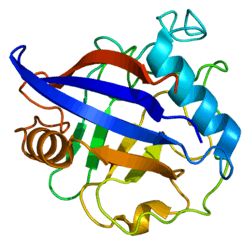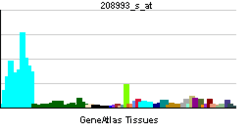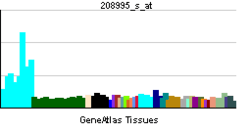PPIG (gene)
| Peptidylprolyl isomerase G (cyclophilin G) | |||||||||||||
|---|---|---|---|---|---|---|---|---|---|---|---|---|---|
 PDB rendering based on 2gw2. | |||||||||||||
| |||||||||||||
| Identifiers | |||||||||||||
| Symbols | PPIG ; CARS-Cyp; CYP; SCAF10; SRCyp | ||||||||||||
| External IDs | OMIM: 606093 MGI: 2445173 HomoloGene: 3520 GeneCards: PPIG Gene | ||||||||||||
| EC number | 5.2.1.8 | ||||||||||||
| |||||||||||||
| RNA expression pattern | |||||||||||||
 | |||||||||||||
 | |||||||||||||
 | |||||||||||||
| More reference expression data | |||||||||||||
| Orthologs | |||||||||||||
| Species | Human | Mouse | |||||||||||
| Entrez | 9360 | 228005 | |||||||||||
| Ensembl | ENSG00000138398 | ENSMUSG00000042133 | |||||||||||
| UniProt | Q13427 | A2AR02 | |||||||||||
| RefSeq (mRNA) | NM_004792 | NM_001081086 | |||||||||||
| RefSeq (protein) | NP_004783 | NP_001074555 | |||||||||||
| Location (UCSC) | Chr 2: 170.44 – 170.5 Mb | Chr 2: 69.72 – 69.75 Mb | |||||||||||
| PubMed search | |||||||||||||
Peptidyl-prolyl cis-trans isomerase G is an enzyme that in humans is encoded by the PPIG gene.[1][2][3]
Interactions
PPIG (gene) has been shown to interact with Pinin.[4]
References
- ↑ Nestel FP, Colwill K, Harper S, Pawson T, Anderson SK (Jan 1997). "RS cyclophilins: identification of an NK-TR1-related cyclophilin". Gene 180 (1-2): 151–5. doi:10.1016/S0378-1119(96)00436-2. PMID 8973360.
- ↑ Bourquin JP, Stagljar I, Meier P, Moosmann P, Silke J, Baechi T, Georgiev O, Schaffner W (Jul 1997). "A serine/arginine-rich nuclear matrix cyclophilin interacts with the C-terminal domain of RNA polymerase II". Nucleic Acids Res 25 (11): 2055–61. doi:10.1093/nar/25.11.2055. PMC 146702. PMID 9153302.
- ↑ "Entrez Gene: PPIG peptidylprolyl isomerase G (cyclophilin G)".
- ↑ Lin, Chun Lun; Leu Steve; Lu Ming Chu; Ouyang Pin (Aug 2004). "Over-expression of SR-cyclophilin, an interaction partner of nuclear pinin, releases SR family splicing factors from nuclear speckles". Biochem. Biophys. Res. Commun. (United States) 321 (3): 638–47. doi:10.1016/j.bbrc.2004.07.013. ISSN 0006-291X. PMID 15358154.
Further reading
- Strausberg RL, Feingold EA, Grouse LH et al. (2003). "Generation and initial analysis of more than 15,000 full-length human and mouse cDNA sequences.". Proc. Natl. Acad. Sci. U.S.A. 99 (26): 16899–903. doi:10.1073/pnas.242603899. PMC 139241. PMID 12477932.
- Dubourg B, Kamphausen T, Weiwad M et al. (2004). "The human nuclear SRcyp is a cell cycle-regulated cyclophilin.". J. Biol. Chem. 279 (21): 22322–30. doi:10.1074/jbc.M400736200. PMID 15016823.
- Beausoleil SA, Jedrychowski M, Schwartz D et al. (2004). "Large-scale characterization of HeLa cell nuclear phosphoproteins.". Proc. Natl. Acad. Sci. U.S.A. 101 (33): 12130–5. doi:10.1073/pnas.0404720101. PMC 514446. PMID 15302935.
- Jin J, Smith FD, Stark C et al. (2004). "Proteomic, functional, and domain-based analysis of in vivo 14-3-3 binding proteins involved in cytoskeletal regulation and cellular organization.". Curr. Biol. 14 (16): 1436–50. doi:10.1016/j.cub.2004.07.051. PMID 15324660.
- Lin CL, Leu S, Lu MC, Ouyang P (2004). "Over-expression of SR-cyclophilin, an interaction partner of nuclear pinin, releases SR family splicing factors from nuclear speckles.". Biochem. Biophys. Res. Commun. 321 (3): 638–47. doi:10.1016/j.bbrc.2004.07.013. PMID 15358154.
- Gerhard DS, Wagner L, Feingold EA et al. (2004). "The status, quality, and expansion of the NIH full-length cDNA project: the Mammalian Gene Collection (MGC).". Genome Res. 14 (10B): 2121–7. doi:10.1101/gr.2596504. PMC 528928. PMID 15489334.
- Rual JF, Venkatesan K, Hao T et al. (2005). "Towards a proteome-scale map of the human protein-protein interaction network.". Nature 437 (7062): 1173–8. doi:10.1038/nature04209. PMID 16189514.
- Olsen JV, Blagoev B, Gnad F et al. (2006). "Global, in vivo, and site-specific phosphorylation dynamics in signaling networks.". Cell 127 (3): 635–48. doi:10.1016/j.cell.2006.09.026. PMID 17081983.
| |||||||||
